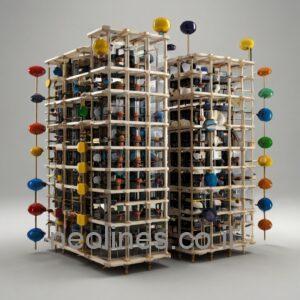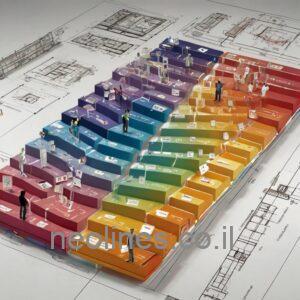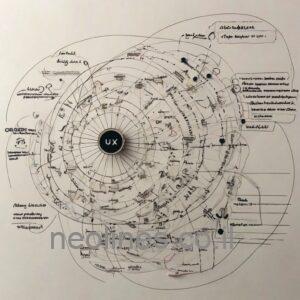You run a serious business, but your mother-in-law insists you don’t need a website — after all, all her friends are on Facebook. And your butcher swears SEO isn’t for his shop: “People come for the grill meat anyway.” Don’t listen to anyone. A forward-thinking business needs a solid ship for a successful voyage.
A corporate website is not just a set of pages — it’s a strategic process that integrates SEO architecture, semantic modeling, UX engineering, and high-speed frontend development. Such a site becomes a true digital asset, delivering measurable ROI by ensuring visibility, trust, and engagement in a competitive landscape.
Get FREE Proposal Now
What the Client Gets: Cognitive Diversification of a Digital Asset
As a result of the full-cycle integration — from strategic decomposition to interface visualization, from semantic engineering to SEO initiation — the client receives not just a website, but an intellectualized digital infrastructure, embedded into a trajectory of long-term growth.
This is not a product, but an evolutionary mechanism that combines cognitive precision, technological scalability, and marketing adaptability.
1. A Semantically Transparent Digital Platform
The site architecture is built not on templates, but on an ontological model of user intent — meaning each page carries strategic weight: it resolves specific intents, aligns with search behavior, and enhances perceived authority.
The semantic core acts as a gravitational SEO center: it not only generates visibility in search, but crystallizes behavioral loyalty from the audience.
→ The client receives a website whose structure doesn’t just get indexed — it transmits business meaning in a format readable by Google’s algorithms.
2. A Technologically Adaptive Frontend and Scalable Backend
The frontend is built on a modern reactive stack (Next.js, Tailwind, ShadCN UI), optimized for Core Web Vitals and mobile-first UX.
The backend is a headless infrastructure (Strapi or WordPress REST/GraphQL), optimized for fast content delivery, secure editing, and independent scalability.
→ The client gets not just a “showcase,” but a digital platform with engineering-grade stability and content-growth readiness.
3. Enterprise-Grade SEO Infrastructure
Automated SEO elements (title, description, schema.org, canonical, hreflang) are embedded across semantic and taxonomic layers.
Semantic-driven UX is implemented — each page, card, and block serves a defined intent-driven function.
→ The client receives a site that doesn’t require manual SEO pushing — it is already structurally prepared for relevant indexing and search expansion.
4. A Content System Aligned with E-E-A-T Principles
Content is crafted with respect to the psycholinguistic patterns of the target audience, covering both transactional and latent queries.
Each page is infused with material that reflects Experience, Expertise, Authoritativeness, and Trustworthiness (E-E-A-T) — the cornerstones of Google Search AI.
→ The client receives not a bundle of text, but a cognitively charged information asset that works for brand growth, reputation, and engagement.
5. Integrated QA and CI/CD Pipeline
Before public release, the site undergoes multilayered testing: responsiveness, performance, SEO validation, interactivity, micro-animations.
A full CI/CD pipeline (Vercel, GitHub Actions) ensures safe and continuous deployment with no downtime.
→ The client receives a technically secured platform where updates are fast, safe, and fully controlled.
6. Initiation of Organic Growth: SEO Without Gimmicks
The process of indexation infusion is launched: the site is registered in analytics systems, sitemaps are submitted, baseline link clusters are created.
Progressive SEO embedding is initiated — growth through content variation, FAQ blocks, semantic expansion, blogs, and case studies.
→ The client receives a platform that doesn’t “wait for SEO” — it’s already integrated into algorithmic ecosystems and begins accumulating search capital from day one.
7. Guaranteed Readiness for Digital Expansion
The website is designed with modularity and semantic redundancy, enabling seamless addition of new products, services, regions, and content pages.
The semantic map is not frozen at launch — it contains vector reserves for future segments, subcategories, and expert materials.
→ The client receives not a “website for now,” but an infrastructure capable of growing with the business — without architectural rework.
Request a Calculation
Stage of Strategic Design for a Corporate Web Resource: Semantic, Marketing, and Organizational-Technical Foundation
 The initiation of a corporate website project for a structured business with a long-term digital strategy is not merely the start of a technical endeavor — it is an entry point into a multilayered systemic process that unites business modeling, semantic decomposition, marketing positioning, and UX architecture.
The initiation of a corporate website project for a structured business with a long-term digital strategy is not merely the start of a technical endeavor — it is an entry point into a multilayered systemic process that unites business modeling, semantic decomposition, marketing positioning, and UX architecture.
At this stage, in-depth strategic discussions are held with top executives or authorized representatives of the company, including:
-
Detailing corporate goals in the digital environment (positioning, target audiences, value propositions);
-
Setting objectives across multiple domains: marketing, IT infrastructure, brand design, and commercial KPIs;
-
Formalizing responsibility: clarifying roles between parties — who provides the source content, who approves project phases, who exercises iterative oversight;
-
Identifying key internal and external constraints — legal, technological, organizational, and competitive.
This forms the informational-functional perimeter of the project, within which a unified ontology of meanings, tasks, and responsibilities emerges between client and contractor.
The result of this phase is a roadmap for the digital transformation of the company’s online presence — one that reflects both internal processes and external communication mechanisms, framed by a clear semantic and strategic structure.
Keyword Research. Semantic Mapping: Strategic Exploration of Search Queries as the Basis for Long-Term Positioning
In the context of designing a digital infrastructure for a mature, future-oriented business, keyword research transcends the mechanical aggregation of search volumes. It becomes an intellectual exploration of the semantic landscape — akin to aerial reconnaissance of an industry terrain, where each pixel represents a potential growth vector.
This stage is not directly subordinated to marketing or commercial metrics. It follows a broader and more independent logic — that of an observer who rises above the habitual routes of competition and peers into what remains unnamed, unclaimed, and unexplored.
Keyword Research as Strategic Satellite Scanning
 Here, the analyst is not a mechanic but a cognitive navigator:
Here, the analyst is not a mechanic but a cognitive navigator:
-
A lexical topography of user needs, pain points, and goals is constructed;
-
Search intents are decoded in their dynamic form — from latent curiosity to transactional commitment;
-
Indirect and horizontal competitors become visible — those operating outside the immediate field of vision;
-
Adjacent, unoccupied demand zones are identified — potential frontiers for business expansion.
And at some point in this process — like a clearing above the mountains on a clear day — gaps appear:
Thematic zones that were previously veiled in the fog of template thinking.
Moments where meaning meets inspiration.
Goal: To Build a Scalable Semantic Matrix
At this level, we do not merely compile a list of keywords — we construct a deep strategic map of meanings, where:
-
Each direction can evolve into a standalone digital entity (page, service, case study);
-
The site structure is designed not “for now,” but with a multi-year trajectory in mind;
-
Growth is proactively designed, rather than reactively adapted to existing demand.
Outcome: A Reservoir of Contexts and Opportunities
The result is a semantic infrastructure capable of evolving alongside the business.
Here, analytical precision is fused with intuitive depth —
and such research often becomes a source of fresh insights and semantic momentum for the team.
This is its unique value:
Intellectual SEO doesn’t just build a foundation for visibility —
it opens up horizons that inspire forward motion.
Semantic Core Creation: Building a Strategic Energy Resource for the Company’s Digital Ecosystem
The creation of a semantic core within the framework of strategic web development is not a mechanical procedure of keyword compilation — it is the design of a meaning model, akin to a nuclear matrix that concentrates the quantum potential of business development in the informational domain.
It represents a structured array of target meanings that reflect the cognitive landscape of the audience, encompassing:
-
Psycholinguistic patterns of thought;
-
Verbal models of pain points, needs, desires, and psychological triggers;
-
Latent intents and motivations encrypted in user search behavior.
The Semantic Core as a Strategic Vector of Digital Gravity
 On a conceptual level, the semantic core (SC) is an ontological representation of the semantic space within which all key elements of digital positioning are formed:
On a conceptual level, the semantic core (SC) is an ontological representation of the semantic space within which all key elements of digital positioning are formed:
-
Site architecture;
-
Content strategy;
-
Page structures;
-
Social media funnels;
-
Expert publications and PR strategies;
-
Voice search and video SEO.
The semantic core becomes the gravitational center for relevant traffic — crystallizing verbal holograms of user attention and attracting precisely those visitor clusters that align with the company’s business goals.
Potential, as in Nuclear Physics
Just as an atom holds immense energy within its nucleus, a properly structured semantic core carries explosive marketing and conversion potential. This potential can be activated through:
-
SEO channels;
-
Email strategies;
-
Content marketing;
-
Organic publications;
-
Sales scripts and FAQ modules.
The Semantic Core as a Mental Map of the Target Audience
 The SC becomes a topographic model of user consciousness — illustrating how different audience segments articulate their questions, how they think, how their vocabulary differs, and what language they use to seek solutions.
The SC becomes a topographic model of user consciousness — illustrating how different audience segments articulate their questions, how they think, how their vocabulary differs, and what language they use to seek solutions.
Thus, the semantic core is not just a “keyword list,” but:
-
A cognitive imprint of the target audience;
-
A verbal model of commercial demand;
-
A strategic framework for content expansion;
-
A universal interface for interaction with the digital world through search technology.
Conclusion:
Creating a semantic core is a foundational stage of semantic engineering in a digital project.
It is the point where user language, business goals, and search engine logic converge into a unified structure — capable of ensuring thematic dominance, search relevance, and content scalability for sustained long-term growth.
Keyword Mapping: Taxonomic Decomposition of the Semantic Core and Semantic Morphology of Pages
Following the formation of an extended semantic core — encompassing thousands of lexemes, intents, and thematic clusters — one of the most critical phases in strategic SEO begins: Keyword Mapping. This involves the precise distribution of key semantic components across specific landing pages of the digital resource.
This process is a multidimensional cognitive-semantic operation, where language, meaning, architecture, and the future structure of the user interface are integrated into a unified system.
Objective: Structural Decomposition and Semantic Modeling of Landing Zones
Even with a semantic core containing 5,000+ key units, it is crucial to ensure:
-
Contextual relevance of each page — every document must solve a specific semantic task;
-
Lexical balance — avoiding keyword stuffing, duplication of meaning, or overlap of intents;
-
Informational harmony — each page should carry a unique semantic load while remaining part of a unified content-navigation framework.
Architectural Semantics and Preliminary UX Planning
At this stage, the semantic foundation of the future information architecture is laid.
Keyword Mapping is inseparable from the planning of future pages, defining:
-
Structural blocks (intro, pain points, benefits, FAQ, reviews, case studies, downloadable files, specs);
-
Content containers (tables, tabs, video modules, photo galleries, interactive elements);
-
Modal layers of meaning — from main headers to hidden tabs and annotations.
Every interface unit should carry relevant semantics — not only in headings, but in lists, captions, background visuals, and supporting blocks.
Modularity and Vertical Content Strategy
Keyword Mapping also serves as the foundation for future content expansion.
Semantics that exceed the capacity of primary pages should be reserved for:
-
Expert blog publications;
-
Analytical overviews and industry insights;
-
User Q&A, FAQs, and customer service modules;
-
PR content, case studies, interviews, glossaries;
-
Visual and multimedia formats (video reviews, infographics, presentations).
This creates a semantically interconnected network of pages, where each publication is not an isolated text, but a node in a meaning system that reinforces the authority and cluster relevance of the main site.
Evolutionary Flexibility and Strategic Scalability
A well-implemented Keyword Mapping strategy enables you to:
-
Not just write content “for now”,
but build a semantic infrastructure for long-term growth; -
Adapt content to future business expansion — new products, services, markets;
-
Integrate neuro-semantic UX support at the level of microstructures.
Conclusion:
Keyword Mapping is not merely the distribution of keywords.
It is the semiotic architecture of the future site — where every lexeme is a brick, every page a frame, and the entire project a thinking organism capable of scalable growth, deep indexing, and multi-channel engagement with the target audience.
UI-Audit & Visual Identity Mapping: Cognitive-Perceptual Calibration of the Interface as Part of a Multisensory Digital Strategy
At this stage of corporate web development, we transition into a domain deeply tied to the visual-perceptual representation of the digital interface — that is, UI analytics (User Interface). This is a systemic process of visual-communicative modeling, blending aesthetics, brand psychology, and behavioral interface patterns.
The objective here is to identify the visual preferences of the target audience, define a visual identity vector, and lay the foundation for interface-graphic prototyping — aligned with both business objectives and user expectations.
Deconstructing UI Workflows: From Neuroperception to Visual Homeostasis
Every interface-level visual decision is not just a matter of “design taste” — it is a cognitive and semiotic intervention in how users perceive and interact. The UI governs first impressions, directs attention, reduces cognitive load, and establishes initial trust — in both the brand and its information.
Color Scheme Analysis
Color is the language of emotion. It defines the mood of the website and helps users intuitively sense the company’s ethos. Palettes are selected based on:
-
Desired emotional response (trust, energy, calm);
-
Target audience specifics (B2B ≠ lifestyle);
-
Differentiation from competitors through associations and recognizability.
For instance, blue often signals reliability, while orange conveys motivation to act.
Competitor Visual Pattern Analysis
The goal is not to imitate, but to understand visual habits of perception.
Each industry develops common UI expectations — where the filter is located, how pricing is shown, what a call-to-action looks like. Analyzing competitors allows us to:
-
Identify standard patterns to lower the learning curve for new users;
-
Understand what already works and where creative differentiation is possible;
-
Integrate the brand into the industry’s “visual language” while retaining uniqueness.
Refining UI Element Form Factors
Each button, card, icon, or margin is a point of contact between the user’s attention and the interface. We consider:
-
Visual rhythm and modularity (structural readability);
-
Microinteractions — hover states, animations, click responses (bringing the interface to life);
-
Touch-oriented design for mobile — dimensions, spacing, tactile emulation.
These combine to form not just an interface, but a visually tactile environment.
Typography, Spacing, Visual Modules
Typography is a textual interface. It influences reading pace and semantic perception. We configure:
-
A clear hierarchy of headers and subheadings for easy page scanning;
-
Optimal spacing and line height so text “breathes”;
-
Grid-based modules that align the visual flow of content.
Typography sets the tone and rhythm of communication, making the site feel sophisticated or dynamic.
Photography, Icons, Visual Style
The visual language of a brand is formed not only by color, but by imagery.
-
Photos must feel authentic, natural, and reflective of the business reality.
-
Icons are micro-meanings that users recognize faster than text.
-
Style is the unified visual code that makes the site memorable.
We don’t just “pick pictures” — we craft visual metaphors that enhance the brand’s message.
Goal: To Construct a Visual-Behavioral Architecture That Supports Semantics
UI is not just the “appearance.”
It is the visual grammar of the website, translating meanings embedded in SEO and UX architecture.
Through interface aesthetics, the user first perceives semantics, makes an engagement decision, and either trusts or rejects the structure you’ve built.
Conclusion:
UI development requires more than artistic flair — it demands:
-
Knowledge of neuropsychology and perception;
-
Mastery of visual semiotics;
-
Awareness of industry-specific design trends;
-
The ability to build visual structures that align with content blocks, SEO frameworks, and UX logic.
UI isn’t “about beauty.”
It’s about coherence between the visual surface and the underlying semantic architecture — a point of contact between the eye, the mind, and the business.
Semantic-Driven UX: Designing User Experience as a Continuation of Semantic Architecture
Once the SEO model is built and semantic clustering is complete, the next logical step is UX design born from meaning.
Here, we don’t simply draw attractive blocks — we craft a content structure fully aligned with user intent, perceptual logic, and business goals.
Unlike traditional UX — often centered around “user journeys” without semantic context — the Semantic-Driven UX approach begins with understanding:
What exactly does the user seek?
What are their expectations?
How can we deliver the information with clarity and purpose?
Each Page as a Complete Semantic Unit
Pages are designed not as visual surfaces, but as information containers that solve specific tasks:
-
A service page explains not just what is offered, but why it matters and who it’s for;
-
A case study page reveals the process, logic, and outcomes — transforming experience into expertise;
-
A product page includes not only specifications but also options, alternatives, media, explanations, and contextual use.
Structure Not Just of Blocks, But of Semantic Zones
Each block on the page is a logical unit answering a potential user question. These may include:
-
An introductory paragraph explaining the core value;
-
A problem-solution section;
-
Unique advantages compared to alternatives;
-
Use cases or portfolio;
-
Technical data, tables, instructions;
-
Frequently Asked Questions (FAQ);
-
A trust-anchored Call to Action (CTA).
The sequence and depth of these zones are driven not by design whim, but by perceptual logic and search intent.
UX Based on SEO — Not Just Usability, But Semantic Precision
When a page’s structure arises from semantic core analysis, the resulting interface:
-
Speaks the user’s language;
-
Anticipates questions and delivers immediate answers;
-
Guides action naturally, with minimal friction.
This is the essence of an intent-driven structure — the kind Google recognizes as expert-level content.
Why Google Favors It
Modern search engines no longer rely solely on keywords and titles. Algorithms now evaluate:
-
How logically and thoroughly the topic is addressed;
-
Whether content is structured and diverse;
-
If the page genuinely assists decision-making or simply “makes noise.”
Semantic-Driven UX produces high-utility, meaning-rich pages — pages that not only rank well but truly serve business goals.
Technological Infrastructure of a Corporate Website: From Data Architecture to Reactive Frontend
Modern corporate website development is no longer a matter of static page assembly. It is an integration of multi-layered logic combining semantic architecture, interface ergonomics, and advanced engineering implementation. This process unfolds along two synchronized vectors:
Backend: Data Architecture and SEO Infrastructure
At the server logic level, we establish:
- Content types and taxonomies — forming the foundational typology of pages, which is critical for scalable SEO architecture.
- Semantic relations and relational models — enabling structured navigation clusters, related articles, product recommendations, and case linkages.
- SEO elements (title, meta tags, schema.org) — integrated at the data model level for automated generation during content publishing.
- GraphQL or REST API — powering flexible data delivery to the frontend, optimized for SSR (Server-Side Rendering) and SSG (Static Site Generation).
Technologies employed:
- Strapi (headless CMS) — ideal for content-heavy projects requiring flexibility.
- Headless WordPress — suitable for blogs, newsrooms, and press centers.
- PostgreSQL + Prisma ORM — for structured data with strict typing and secure schema generation.
Frontend: Reactive Visualization and Cognitive Ergonomics
Following the creation of a design system (e.g., in Figma), components are migrated into a reactive engineering environment using modern UI libraries and atomic design methodology:
- ShadCN UI / Tailwind CSS / Radix UI — modular interface elements with high customizability.
- Next.js + React — for hybrid SSR/SSG rendering and instantaneous responsiveness.
- TypeScript — providing type safety and robust interface control.
- CI/CD pipelines (Vercel / GitHub Actions) — enabling stable, automated deployments at scale.
Special considerations:
- Mobile-first UX — in response to mobile-dominated traffic (60–90%).
- Page Speed Optimization — through Cloudflare, lazy loading, and code splitting.
- Responsive typography and interactive blocks — essential for retention and engagement.
Frontend as an SEO Factor
Speed, predictability, and stability directly affect SEO performance:
- Core Web Vitals (Google): LCP, CLS, FID — optimized at the framework level.
- Interactive components — when properly implemented, they improve behavior signals without hindering indexing.
- Content diversity (videos, galleries, tables, tabs) — achieved without compromising performance.
Site Builders ≠ Engineering Architecture
For micro-projects and small businesses, builders like Tilda, Wix, or classic WordPress may suffice for a quick launch. But for enterprises aiming at long-term SEO visibility, content authority, and UI resilience, a corporate-level tech stack is essential.
The website becomes a digital asset, an ecosystem woven into the marketing and communication strategy.
Conclusion
The technological stack is more than a set of tools — it’s the foundation of SEO potential, UX reliability, and content dynamics. We engineer reactive digital interfaces that:
- Scale without performance loss;
- Render instantly and index correctly;
- Adapt to future content and visual demands;
- Align with Google’s standards for expertise and diversity.
Content Integration, Publication, and Promotion Launch: Cognitive-Semantic Activation of the Website
Upon completion of semantic modeling, UX design, and technical layout, the next phase begins: cognitive materialization of meaning. This is when the site is filled with content, forms a public identity, and enters into organic interaction with search engines and users.
Content Creation and Verification: From Semantic Task to Cognitive Value
Content is not just text; it is an informational artifact reflecting expertise, utility, and context. It is structured according to the semantic map, intent groups, and content blocks.
Stages:
- Syntactic synergy — text composition based on keyword density, syntactic diversity, and lexical variation.
- Thematic stratification — defining the core, secondary, and clarifying content (e.g., videos, diagrams, lists, images).
- E-E-A-T calibration — ensuring alignment with Google’s standards for Experience, Expertise, Authoritativeness, and Trustworthiness through content format, structure, and detail.
Content blocks must not just exist — they must logically emerge from page architecture, reinforce user intent, and strengthen conversion elements (CTAs, testimonials, benefits, facts).
Publication and QA: Interface and Indexing Validation
Before going live, the website undergoes multi-tier testing:
- Functional QA of all components (interactives, responsive blocks, navigation).
- SEO QA (metadata, canonical tags, schema.org, hreflang, indexing via Search Console).
- UX tests for mobile ergonomics, interaction speed, scroll-depth, visual rhythm, and behavioral triggers.
A thorough content render inspection is conducted: data from CMS must output correctly, APIs must function, and HTML must reflect the semantic blueprint.
Promotion Kickoff: Organic SEO Activation Phase
After publication, the indexation phase begins — integrating the site into search ecosystems:
- Search Console onboarding — registration, sitemap submission, crawl error review.
- Google Index Initiation — forcing indexation of priority pages.
- Initial link-building — foundational backlink profile (directories, brand mentions, basic content).
- Content pulse — publishing 3–5 expert articles in “Blog” or “Press Center” sections to seed thematic relevance.
Analytics setup runs in parallel: Google Analytics, Looker Studio, Bing Webmaster Tools, SERP tracking (Serpstat, Ahrefs, SE Ranking).
Growth Scenario: Progressive SEO-Embedding Strategy
Modern promotion is not a burst but a gradual semantic expansion, achieved through topic coverage, logical navigation, deep content, and authentic voice.
Launch tactics include:
- Periodic audits of indexation and user behavior (scroll maps, click maps, time-on-page).
- Adding new semantic blocks (FAQs, glossaries, case studies, video stories).
- Expanding the semantic depth (LSI terms, new intent groups, geo-clusters).
Conclusion: Content, Publication & SEO Are Not the End — They Are the Birth
This is the moment the website is born as a public semantic system. Here, the meaning architecture encounters the user — and the impact of this meeting determines conversion, brand recognition, and search ranking.
You are not simply “publishing a website” — you are initiating the semantic transmission of your brand — into search engines, into user cognition, into the digital ecosystem.
Final Thought: A Website as a Digital Organism, Not a Web Product
Rather than delivering a typical website, we create a highly structured digital ecosystem where:
- Architecture builds semantic topology;
- Content reflects cognitive patterns of the audience;
- Frontend embodies engineering elegance;
- SEO is embedded into the very fabric of the system.
Expert Maryan Polyak
The approximate price is as follows:
Prices are for informational purposes only and do not constitute a public offer. The final cost of services is determined individually and may vary depending on the terms of cooperation.
Additional language (interface localization, SEO structure, content) — from 25% extra on development cost, depending on the scope of adaptation.
| № | Work Description | Hours | Cost (USD) | |
|---|---|---|---|---|
| Analytics | ||||
| 1 | Keyword Research | 8 | $195 | |
| 2 | Semantic Core Creation | 8 | $195 | |
| 3 | Keyword Mapping | 8 | $195 | |
| 5 | Competitor Analysis | 8 | $195 | |
| 6 | Semantic Model: Structure and Semantic Framework | 8 | $195 | |
| UX Strategy & Architecture | ||||
| 8 | UI Audit: Visual Trust and Cognitive Calibration | 8 | $195 | |
| 9 | Semantic-Driven UX Design (Intent-Based) | 8 | $195 | |
| Development | ||||
| 10 | Backend (Strapi) | 16 | $390 | |
| 11 | Database Setup | |||
| 12 | CMS System Creation | |||
| 13 | Basic Services Setup (widgets, editor, accessibility…) | |||
| 14 | SEO Services: Schema, Meta, Sitemap | |||
| 15 | API Development and Endpoints | |||
| 16 | DevOps: CI/CD, Deployment, Monitoring, Backup | |||
| 17 | Page Templates Development (Company, Cases, Reviews, Services) | 8 | $195 | |
| Content & Page Implementation | ||||
| 18 | Creation & Publishing of ≈20 Pages (content, SEO, layout) | 50 | $1,215 | |
| Design | ||||
| 19 | Design Mockup Development | 24 | $585 | |
| 20 | Frontend (layout, integration, responsiveness) | 40 | $975 | |
| TOTAL (approx.) | $4,725 | |||
Calculate for My Project
Answers to Questions about Corporate Website for Business
1. Why is strategic semantics essential during the website planning phase?
Answer:
Semantic decomposition transforms a website from a set of pages into a cognitive-information system structured by user intents. It forms the foundation for search visibility and logical UX — every page addresses a specific semantic cluster, rather than merely containing keywords.
2. What is Semantic-Driven UX, and how does it differ from classical UX?
Answer:
Semantic-Driven UX is interface design based on semantic cores and intent groups. Unlike traditional UX, which focuses primarily on visual convenience, this approach is tailored to specific user questions and motivations, enhancing conversions and meeting Google’s expectations for content depth and structure.
3. What is the value of Keyword Mapping?
Answer:
Keyword Mapping is semantic cartography — each page is assigned a clear semantic area of responsibility. It reduces duplication risks, boosts topical relevance, and lays the groundwork for multi-layered SEO expansion (blogs, case studies, glossaries, videos).
4. Why is UI design more than just “visual styling”?
Answer:
UI design is neuroperceptive engineering. Color, rhythm, typography, and micro-animations act as semiotic signals that guide user behavior. A well-executed UI builds trust, reduces cognitive load, and influences behavioral ranking factors.
5. How does a site built on a page builder differ from a custom-engineered frontend?
Answer:
Page builders like Wix or Tilda are great for MVPs and small businesses. But only a custom frontend built with Next.js / React, with SSR and CI/CD pipelines, delivers the speed, SEO depth, and mobile adaptability required for scalable and enterprise-level projects.
6. What is a semantic core in the context of corporate web architecture?
Answer:
A semantic core is not just a keyword list — it’s an ontological model of user meanings. It reflects mental patterns, motivations, pain points, and search logic, becoming a strategic growth engine for the entire digital marketing ecosystem.
7. What frontend technologies are used, and why?
Answer:
Next.js, React, Tailwind CSS, ShadCN UI, and TypeScript enable fast load times, accessibility, modular visual systems, and SEO-friendly architecture. This creates not just a presentation layer, but an interactive, logically structured, and indexable user environment.
8. How does promotion begin after launch?
Answer:
The launch includes technical indexing (Search Console, sitemaps, schema.org), a primary content layer (articles, mentions, directories), and analytical setup (GA4, Looker, SERP tracking). This initiates organic growth based on the site’s semantic architecture.
9. What is E-E-A-T, and how is it reflected in the project?
Answer:
E-E-A-T (Experience, Expertise, Authoritativeness, Trustworthiness) are Google’s content quality guidelines. We embed these principles through expert-level writing, author attribution, structured linking, detailed content, and visual evidence of credibility.
10. What does the client ultimately receive?
Answer:
The client receives not just a website, but a digital ecosystem — with modular architecture, a strategic semantic foundation, cognitively optimized UX, and a technical infrastructure ready for scalable SEO growth, omnichannel communication, and high conversion rates.
Get My Custom Quote













